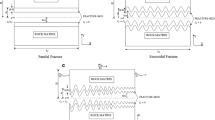Abstract.
Fractures are one of the major travel paths for contaminant transport and dispersion within a rock mass. In this paper, a methodology that combines the orthogonal fractured network and the mass conservation theorem is developed to allow safety assessment in a fractured rock mass. Information equivalent to fracture geometric characteristics is used to establish the orthogonal fracture network. The transport model is further implemented to investigate radioactive contaminant migrations in the fractured media. In addition, this paper employs the proposed methodology in accordance with the investigated data on a radioactive waste disposal site in Lan-Yu, Taiwan. Results indicated that the attenuation of concentration was due to the radioactive decay and the sorption of fractures. Comparison of the transport simulations between 137Cs and 60Co shows that the environmental impact of 137Cs is more obvious than that of 60Co. 137Cs requires more time and more distance to reduce the concentration of the contaminant plume to below the maximum permissible activity.
Similar content being viewed by others
Author information
Authors and Affiliations
Additional information
Electronic Publication
Rights and permissions
About this article
Cite this article
Chen, RH., Lee, CH. & Chen, CS. Evaluation of transport of radioactive contaminant in fractured rock. Env Geol 41, 440–450 (2001). https://doi.org/10.1007/s002540100410
Received:
Accepted:
Issue Date:
DOI: https://doi.org/10.1007/s002540100410




